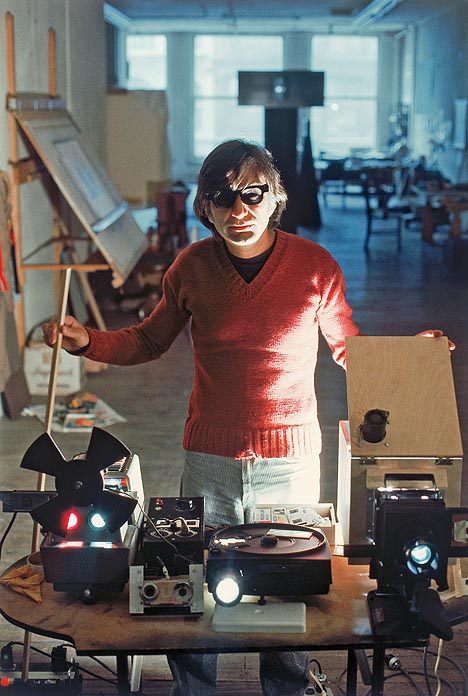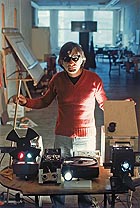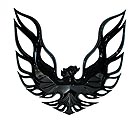
translated and summarized by: Liz Wollner-Grandville,
English summary April 20 - 27
Kunsthalle Bielefeld: 1968. The Great Innocence
The Bielefelder Kunsthalle reveals how the art system was adjusted during the 1960s. The extensive show displays more than 300 works, which demonstrate how weighty these major changes still are today.
Mario Merz became widely known in the 1960s for his art, which rejected eternal value and museum consecrations. The Milan born artist’s rejection was so far reaching that he constructed archaic looking shacks with everyday objects. Noteworthy are his igloo-like objects, which are meant to depict an “ideal organic form” and are composed of small sandbags. To literally “enlighten” the poetic texture of the objects with writing, Merz adds neon lamps twisted in the form of words. One of these dwellings is displayed at the current Bielefeld exhibition.
The huge exhibition “1968. The Great Innocence”, whose title is irritating at first, shows 300 works, which demonstrate how artists questioned the art system during the political rebellion in 1968, and their questioning was not in the least innocent. The curator Thomas Ellein analyzes American, European, and Asian art as well as visionary architecture. He presents examples of Pop Art, Fluxus, Happening, Performance, Land Art and Conceptual Art . All of these movements, which at the time were misunderstood by the audience, marginalized by the market, and scandalised by the media – completely redefined art methods, media and materials. Ranging from the utilization of abstract terminology, human bodies, and electronic media, new forms of happenings were developed, which clearly rejected the until then classic understanding of art.
In this connection, a large part of the show is devoted to examples of the Austrian art revolt. Günter Brus’ “Malerei- Selbstbemalung-Selbstzerstörung” (Painting-self-painting-self-destruction) as well as works by Christian Ludwig Attersee, Arnulf Rainer, Valie Export, and Peter Weibel are presented to the Bielefeld audience in the form of photographs and documentations. A chapter in the catalogue written by Roman Grabner is devoted to Viennese Actionism titled “geht’s heim zu mutti” (“Go home to mom”). He describes Hermann Nitsch’s “Orgien-Mysterien-Theater” (Orgy-Mystery-Theatre) as well as VALIE EXPORT’s and Peter Weibel’s street actions and thereby introduces the special Austrian art revolt, which, unlike Germany, did not take place in parallel with the political protest of the leftists.
Strictly speaking, 1968 does not mark the year of upheaval and change – at least in the art world this turnaround already commenced in the mid 60s. The international context into which Thomas Ellein positions the 1960s and 70s offers an insight into the substantial transformations of art on an international level. This is, for example, clearly displayed by works by Yayoi Kusama (Japan/New York), Milan Knizak (Czech Republic) or Jerzy Beres (Poland) and contrapositions the “art phenomenon of the 60s” with the political turmoil of the time, which, in contrast to art, did not ensue in an equal number of countries.
This synoptic exhibition clearly demonstrates that today’s art would not be possible without the art of that era. Today’s crossovers, multimedia installations, utilization of everyday objects and the references to mass media makes it clear that contemporary art still strongly depends on the artistic Avant-garde of the 60s and 70s. And maybe the criticism of the system of those days offers, in view of the current global economic crisis, an incentive to rethink the existing system.
By Berenika Partum
1968. The Great Innocence”
March 15 – August 2, 2009
Catalogue: DuMont publishers, 28 € and 49,95 € in bookstores
kunsthalle-bielefeld.de
Essl Museum: Alfons Schilling – 75th Birthday
Rediscover how to see, not how to paint
In case you expected a large retrospective on the occasion of Alfons Schilling’s 75th birthday, you will be disappointed. The Essl Museum only devoted three rooms to his work. His humungous paintings “Autobinäre Stereobilder” (1984 – 1986 and 1992/93) are all hung in a large room. They remind of meticulously painted enlargements of colourful light refractions in a prism. The seemingly Orphic, crystalline play of colours is meant to be viewed with both eyes, however through a monocle – a phenomenon which causes a 3D effect.
Schilling’s holograms and lattice photography, with overlapping layers of photos dating from the late 60s and 70s, are also part of the Essl presentation. “Chicago Demo” (1968) shows impressive photos of gas mask helmets decorated with peace signs, protesters, and a policeman, as well as portraits of Jean Genet and William Boroughs, overlapped in such a way that you can (nearly) experience them as a motion picture - provided you view them in motion.
With the same technique the illusion of ice is achieved in “Iceland II, Brainscape” (1971). “Let me unfocused” is scribbled in red paint on the lower glass edge. “We live in a time that is based on movement and simultaneity. We no longer stand like a tree on one spot. We want to see everything while we move. If I go into a museum, I am continuously moving”, Schilling said in his conversation with Christian Reder in 1988.
All but one of the six so-called Rotation pictures, which he created in Paris, have a diameter exceeding two meters. The “Andromeda” points to the principle of the evolution of stars. The colours, slung at the panes, continue to rotate. Thereby, depending on the rotational speed, new pictures develop out of the colour spots - reminding of Marcel Duchamp’s circular panes. Following his exhibition with Günther Brus and Otto Muehl (1961) he becomes one of the co-founders of the Vienna Actionism. But on account of Schilling’s relocation to New York for a time span of 24 years, his later works no longer had any relationship to this group.
The exhibit clearly demonstrates that Schilling’s goal is not to invent new pictures, but to invent a new approach – a new way of seeing. “Until now space is only a feeling.” (Schilling, 1961). He considers himself as an artist and researcher in a scientific dialogue. His visual experiments in which appliances that he built himself are used, such as the “Video-head-set” (1973) pre-empt the idea of a cyber-space visionary, as Peter Weibel ascertained. There is only one photo of Schilling at the Essl exhibition together with one of his viewing devices. Therefore, unfortunately, the most distinguished part of Alfons Schilling’s work is missing.
By Renate Quehenberger
Essl Museum
3400 Klosterneuburg, An der Donau-Au, until 24.05.09
www.essl.museum
Galerie mezzanin: Alexander Wolff
Exhibition for those passionately interested in themselves – cause & effect
Every week Alexander Wolff varies the way his works are hanged at the Galerie Mezzanin. His witty concept encourages the audience to revisit his exhibition, possibly even several times and it allows the onlooker to discover how his/her own perception of the artwork reacts to the relocation. The title “Exhibition for those passionately interested in themselves” can be interpreted as a poetic subtext for this concept.
Based on the concept of Minimal Art, the artist draws on industrialized formats or incorporates the on-site situation into the formal process. The gallery’s doors and windows are blended into his compositions, whereby the play with light and shadow develops to a consistent motif for the white, gray and black nuances of his works. By changing the position of his paintings, Wolff creates aesthetically paradox circumstances: they contrast with the background and produce provocative and fascinating effects.
In comparison to finalized art products, Wolff extends the scope by fading the visual information either in or out. In his series “Non Commodities” (2009) the textile works function as a frameless - through their Velcro fasteners - counterpart to the so-called “shaped-canvas”. This allows them to easily be combined in an altered way, whereby transformation processes take place in the works themselves. This permits a continuously new formal aesthetic trace.
By Ursula Maria Probst
Galerie mezzanin
1010 Vienna, Gertreidemarkt 14/Corner Eschenbachgasse , until 02.05.09
www.galeriemezzanin.at
Galerie Ruzicska: Vincent Szarek
American myth: Deep-frozen and tuned
Vincent Szarek is cool, really cool. Sealed into the lacquered cleanliness of his deep-frozen wall- and floor applications it seems as if a starving heart, which has dived deep into the superficialities of the American myth, is still throbbing. A myth, as we have painfully experienced, which no longer exists. In his exhibit at the Gallery Ruziska, Szarek circles around life and the lies of the (bad) dream of the much too wild, wild West, in which John Wayne still rambles through the salon door. The stylised adaption of a more than well-known icon, pressed into the fibreglass form of a beer-drinking prop and lasso swinging lifestyle: manhood. The one-dimensional man in his plain picture world. Minimal. And reduced to the maximum of effectualness.
Just like the “Firebird”, burned to its silhouette, who guards the deep-frozen ado on the show stage of art with stretched out wings. Self-conscious in phase one of an alchemist transformation. For the fashion advanced hipster. High life in high-tech. Where the philosopher’s stone can stretch to a seductively glittering massif of the “San Juan Mountains”. Intoxicated by the greed for gold, out of which one of the mountain sculptures, mythically meaningful and promising, emerges, appears.
But still: as diverging as the fancy artworks may be, they form the visually filtered particles of a superior narration, a cosmos of arrangements set at a lower level. In this particular case, the cultic admiration of “Coors” beer, whose graphic elements are broadened in length and width, and trace a powerful arch towards their clientele: the sports fanatic truckers and wide legged adventurers, the petty criminal outsider and – last but not least – the artist.
Stephan Maier
Galerie Ruzicska
5020 Salzburg, Faistauergasse 12, until 02.05.09
www.ruzicska.com
Mehr Texte von translated and summarized by: Liz Wollner-Grandville


 Teilen
Teilen




